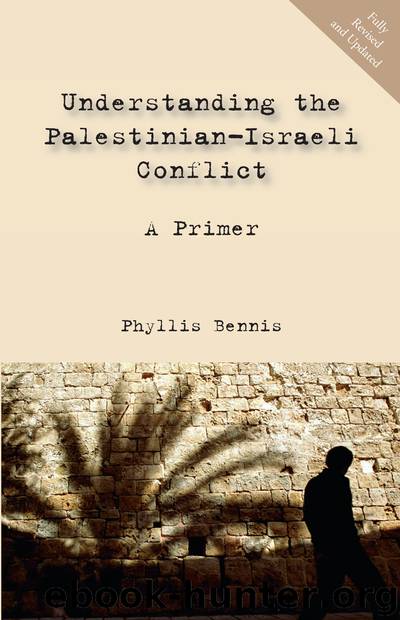Understanding the Palestinian-Israeli Conflict by Phyllis Bennis

Author:Phyllis Bennis [Bennis Phyllis]
Language: eng
Format: epub
ISBN: 978-1-56656-685-8
Publisher: Interlink Publishing
—part iii—
recent history: rising violence
Why did violence break out again in 2000? What is this second “intifada,” and how is it different from the first intifada of 1987–1993?
The second uprising, or intifada, began in September 2000. While the immediate spark was General Ariel Sharon’s walk on the Muslim holy site, the Haram al-Sharif in East Jerusalem, the uprising’s real origins had far more to do with the failed peace process and the dashed hopes and deteriorating lives of Palestinians living under occupation, than with any particular provocation.
The second intifada came seven years after the first intifada ended with the signing of the Oslo accords in 1993. Oslo did not bring about the actual goals of the first intifada—the end of occupation and creation of an independent Palestinian state—but it did hold out the hope that the new diplomatic “peace process” would lead inexorably to such a result. So the nonviolent uprising—including the mass mobilizations, daily commercial strikes, widespread tax resistance, and stone-throwing children that characterized the first intifada—came to a halt with the signing of Oslo’s “Declaration of Principles” on the White House lawn.
Seven long years followed, in which the “peace process” ground on with little result. Especially after the collapse of the Israeli–Palestinian summit sponsored by President Bill Clinton at Camp David in August 2000, Palestinians faced the unfortunate reality that Oslo’s diplomacy had been much more about “process” than about peace. Palestinians’ living conditions and economy had all seriously deteriorated throughout the Oslo years. Israel’s military occupation had become increasingly harsh: closures preventing Palestinians from entering Israel were expanded to prevent travel within and between the West Bank and Gaza; military checkpoints proliferated throughout the “Swiss cheese–style” maze of Israeli control and partial Palestinian authority; house demolitions continued; and settlement construction nearly doubled throughout the occupied territories since Oslo.
The second intifada was the response to those lost hopes. Initially it took similar forms to the first intifada—mass protests in the streets against Israeli military checkpoints surrounding Palestinian cities, including children and youths throwing stones at the tanks and armored vehicles, characterized the first weeks’ mobilization. But the Israeli response was far more brutal than it had been during the first intifada; the stone-throwing protesters the day after Sharon’s provocative visit to the Haram al-Sharif were met with withering fire, killing four and wounding hundreds on the steps and even inside the mosques. The Israeli military immediately began using live fire and tank-fired weapons where once tear gas and rubber bullets might have been used first, and soon helicopter gunships and US-supplied F-16 fighter bombers became regular parts of the Israeli arsenal in the occupied territories.
By March 2002, Amnesty International reported that over 1,000 Palestinians had been killed; more than 200 of them were children.
In response, Palestinians changed their tactics. The mass street demonstrations largely ended as the lethal price exacted by the Israelis for marches and stone-throwing rose. Instead, small armed Palestinian factions took over in challenging the Israeli military occupation forces. Since the Oslo process had
Download
This site does not store any files on its server. We only index and link to content provided by other sites. Please contact the content providers to delete copyright contents if any and email us, we'll remove relevant links or contents immediately.
| Africa | Americas |
| Arctic & Antarctica | Asia |
| Australia & Oceania | Europe |
| Middle East | Russia |
| United States | World |
| Ancient Civilizations | Military |
| Historical Study & Educational Resources |
Empire of the Sikhs by Patwant Singh(23020)
The Wind in My Hair by Masih Alinejad(5056)
Rise and Kill First by Ronen Bergman(4739)
The Templars by Dan Jones(4656)
The Rape of Nanking by Iris Chang(4165)
12 Strong by Doug Stanton(3525)
Blood and Sand by Alex Von Tunzelmann(3164)
Babylon's Ark by Lawrence Anthony(2648)
The History of Jihad: From Muhammad to ISIS by Spencer Robert(2599)
No Room for Small Dreams by Shimon Peres(2343)
The Turkish Psychedelic Explosion by Daniel Spicer(2330)
Inside the Middle East by Avi Melamed(2325)
Gideon's Spies: The Secret History of the Mossad by Gordon Thomas(2319)
Arabs by Eugene Rogan(2279)
The First Muslim The Story of Muhammad by Lesley Hazleton(2245)
Come, Tell Me How You Live by Mallowan Agatha Christie(2228)
Bus on Jaffa Road by Mike Kelly(2123)
Kabul 1841-42: Battle Story by Edmund Yorke(2003)
1453 by Roger Crowley(1994)
